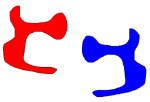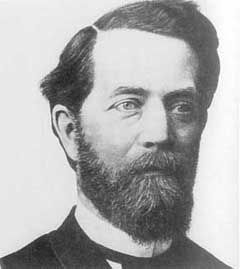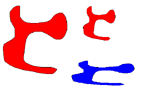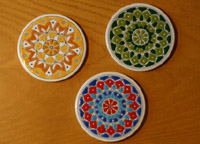The Erlangen Program
This is the text of the poster you can see here.
One Geometry, lots of Geometries
When are two figures (for instance, two plane figures) the “same”? It seems an “innocent” question but you just need to give an answer to realize that it is not so easy. It is not difficult to imagine scenarios in which a different meaning to the word equal must be given – it seems a pun!

Anyone ordering an interlocking puzzle to a carpenter must know if the piece of wood (from which the parts will be cut out) is painted on one of the two faces or is the same on both sides. In the former case, the two figures above must be considered different; in the latter case they are equal.
There are scenarios in which what matters most is just the shape of the figure (the squares of a professor on the blackboard are never equal to those on the exercise books of his students, but nobody seems to realize it and everybody refers to the diagonal of a square….). There are scenarios in which two figures must be positioned in the same way with respect to a coordinate system (writing is a good example: a letter can not be upside down!)
None the less, the procedure is not completely random: the criterion of comparison can change, but not the “rules” underneath it.

In a sense, Felix Klein was the first in 1872 who pointed out a way of giving a good definition of “equality of figures”.
He did it in his dissertation as a new professor at the University of Erlangen; he had to present the new scientific program he would be inspired by in the following years. He managed to combine “the various research areas in Geometry, thus creating a system which made emerge an overview of numerous and new problems, which gave way to further developments”. A fundamental step in the history of modern Mathematics!
The key to arrange the results which crowded geometry books was to interpret Geometry as the investigation of the properties of the figures, which do not change under the action of a “transformation group”. Therefore, there is not just one geometry, but there are lots of them. To choose one of these geometries means to select the “allowed” transformations. Through them, we change a figure into another that is “equal” to the first one. In other words, we choose the “glasses” through which we look at the objects.
For the carpenter mentioned before, the “allowed” transformations are all the isometries if the two faces of the piece of wood are equal. They are the so-called direct isometries (rotations and translations or, in other words, those that do not switch right and left) if just one of the two faces is painted. As another example, in the case of writing, the glasses are those given only by translations.
It is not enough. Some pc programs allow one to take an image and to "stretch" it via two numbers: one is for horizontal "stretching" and the other one is for vertical "stretching". If the two numbers are equal, the shape of the two figures does not change. Even in common language, we say that the two figures are equal by similarity. In general, if the two numbers can also be different, the two figures are said to be equal by an affinity.

It is really difficult to say what is “equal” between two affine figures: even two different shadows (or two different photographs) of the same object (for instance, a circle and an ellipsis) can be equal in this sense.
Yet, our brain can do better. There are even more general methods of recognizing when two objects are equal. In a sense, they are very “natural” for our brain. They are connected to projectivities, which govern the geometry of vision: two different shadows of the same object (for instance a circle and an ellipse, but also a circle and a parabola) can be linked by a projectivity and our brain is well trained to “give substance to shadows” even without projective geometry.
And further… there are the glasses of topology: for them, a doughnut is “equal” to a coffee mug.

